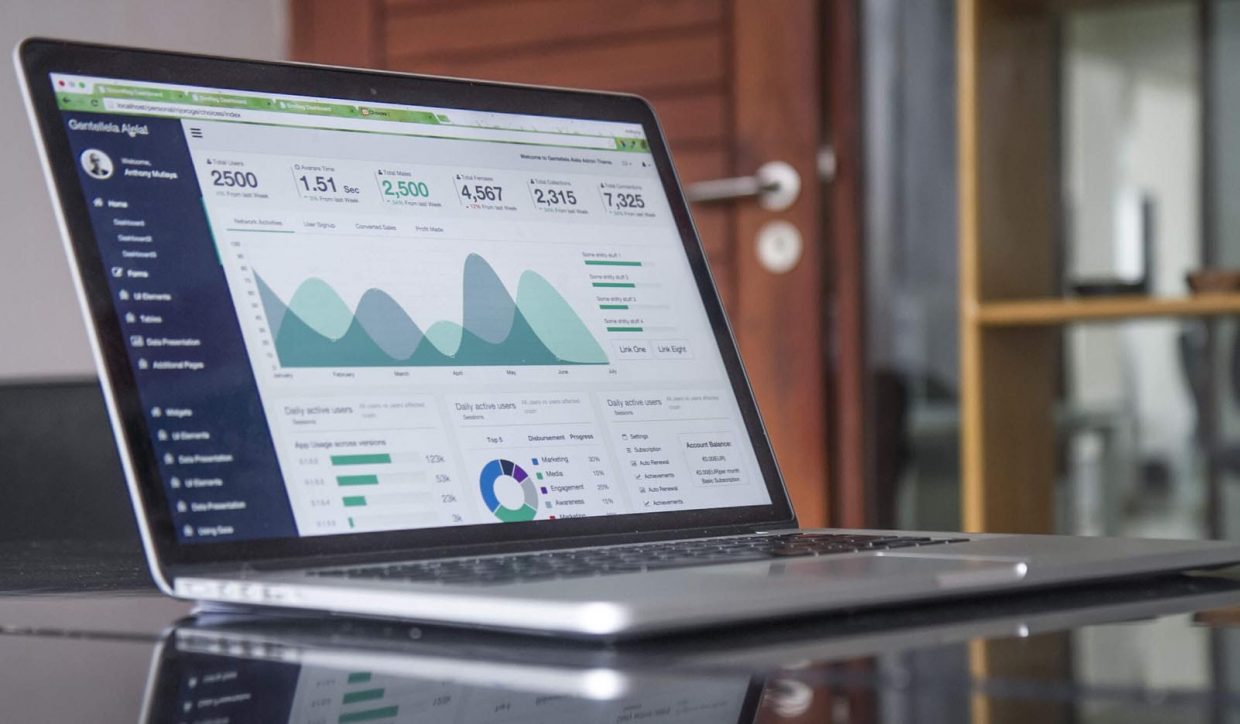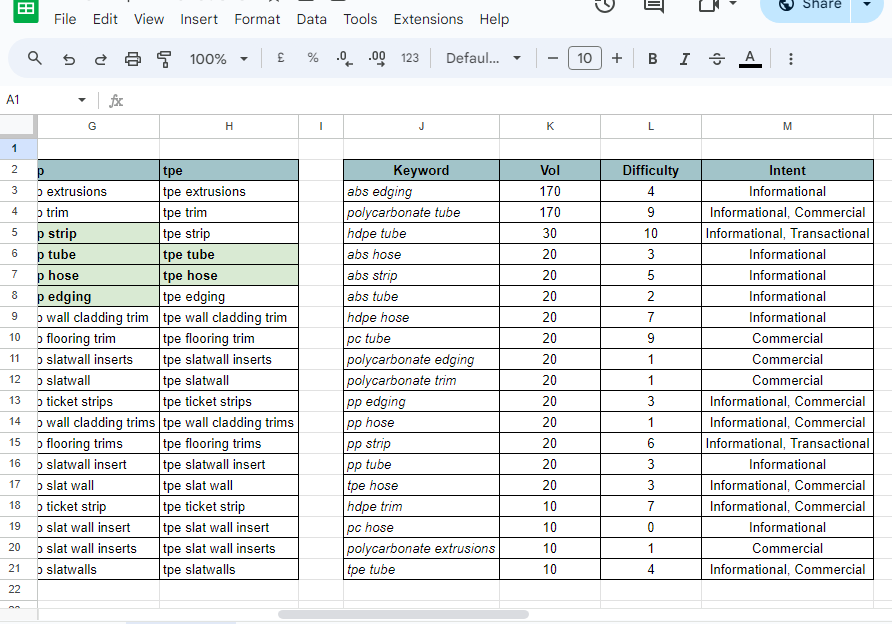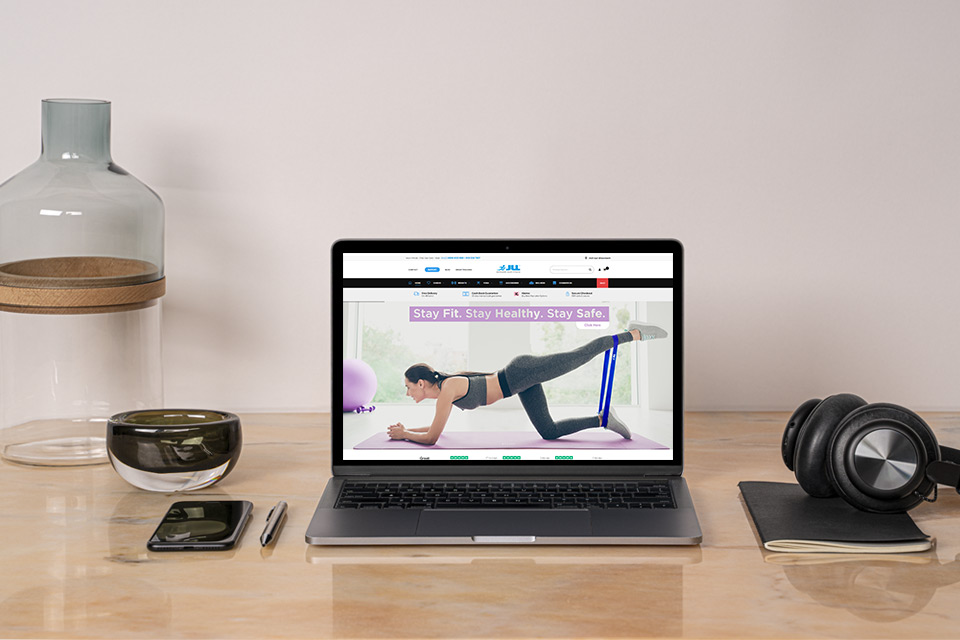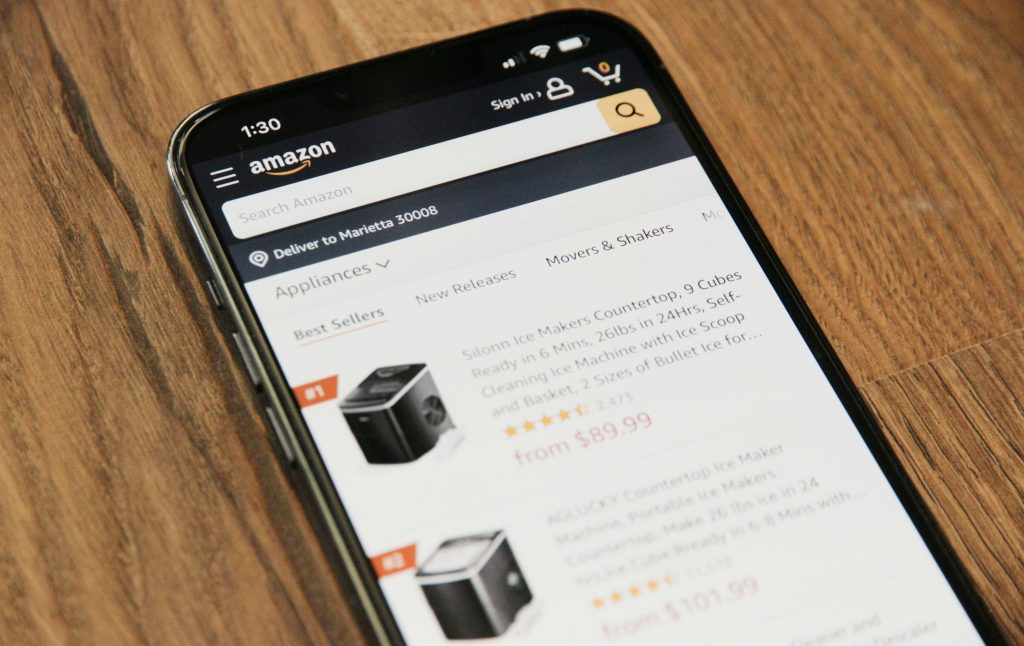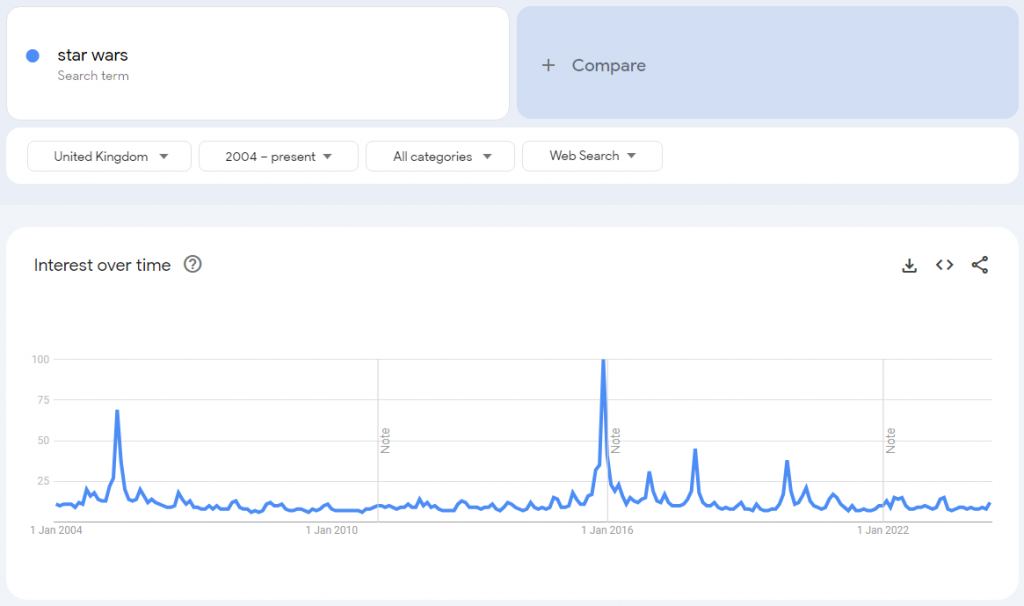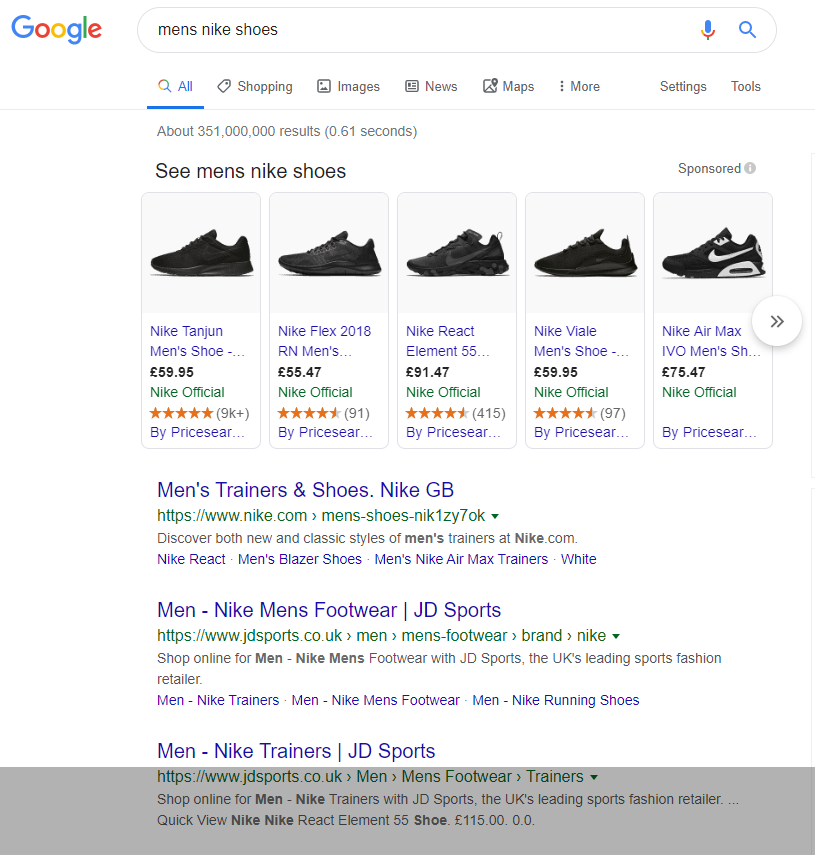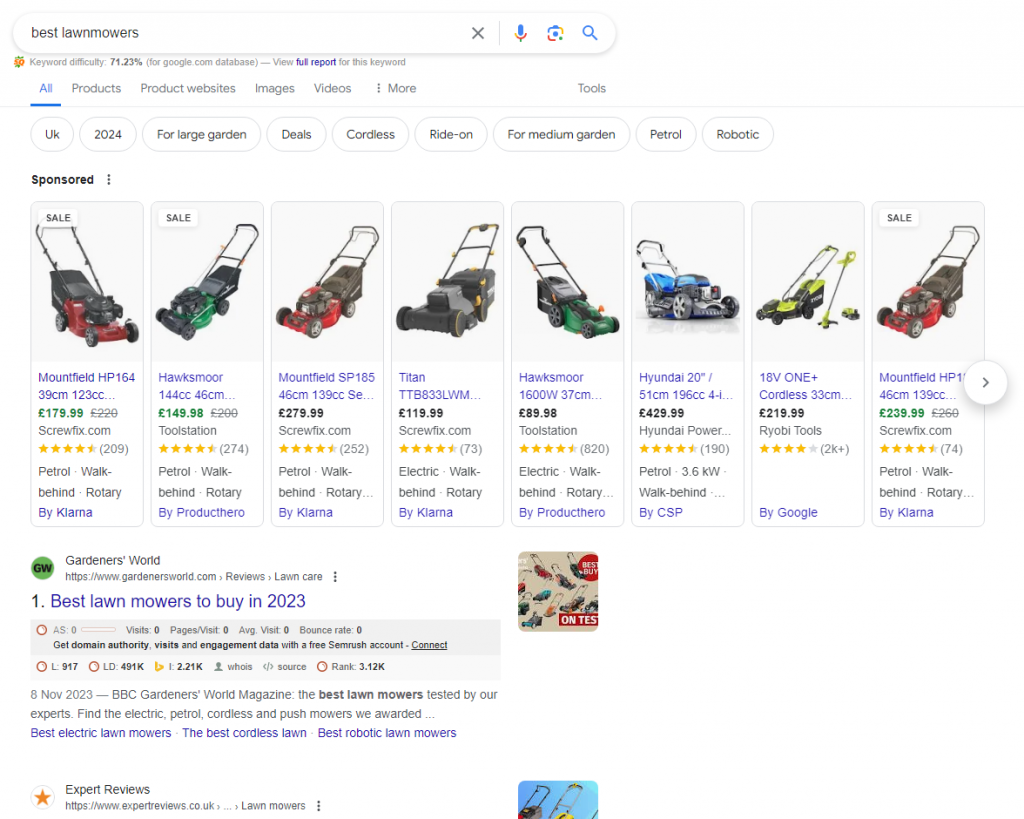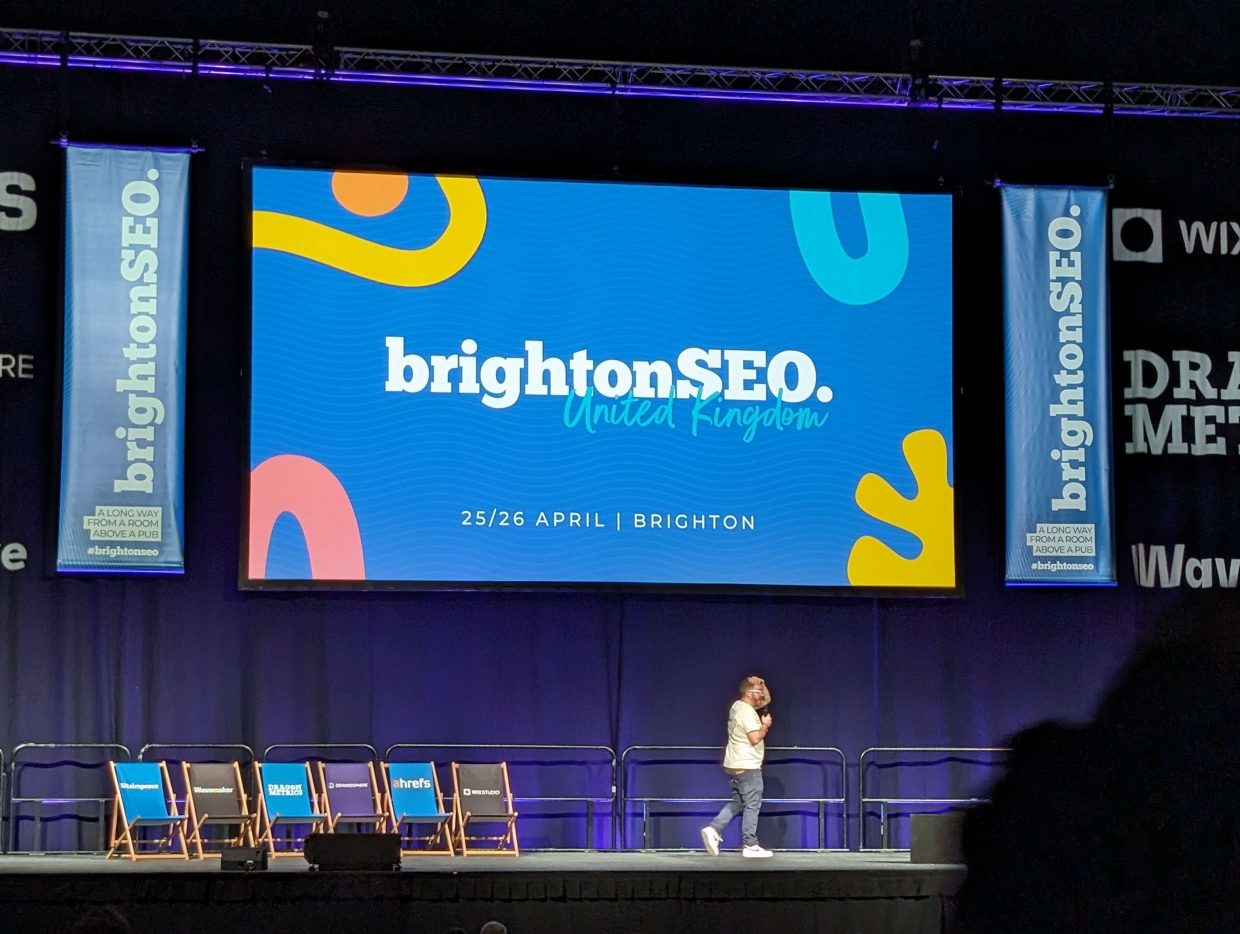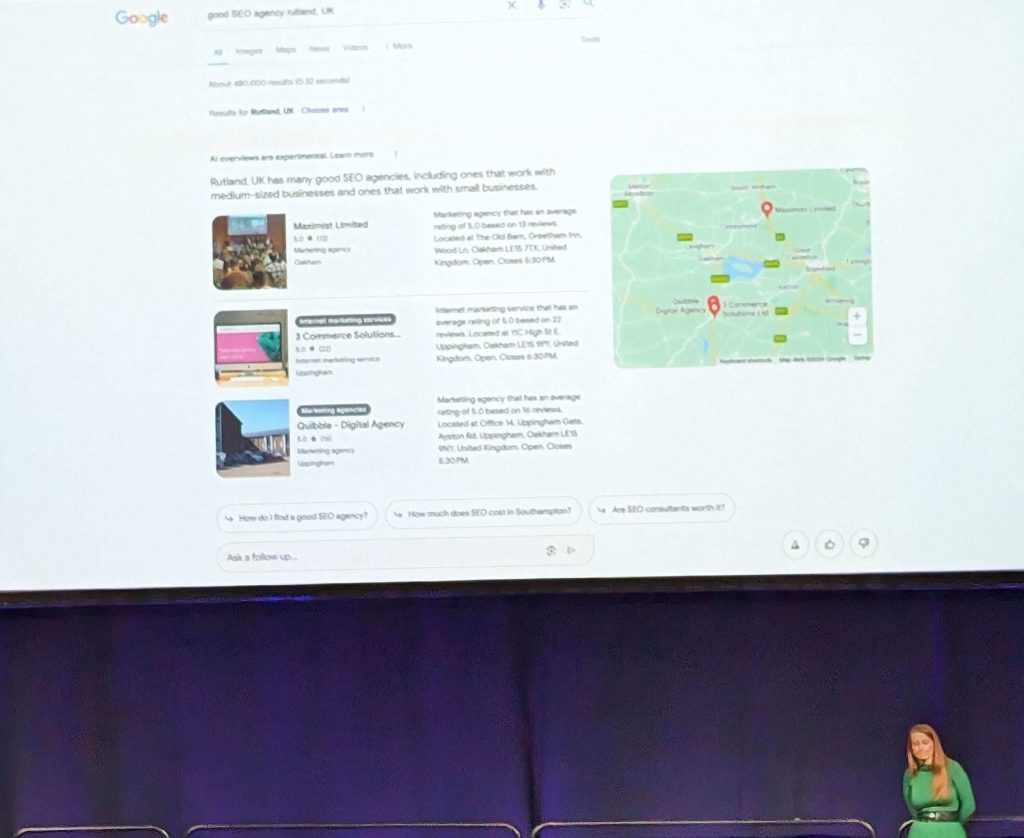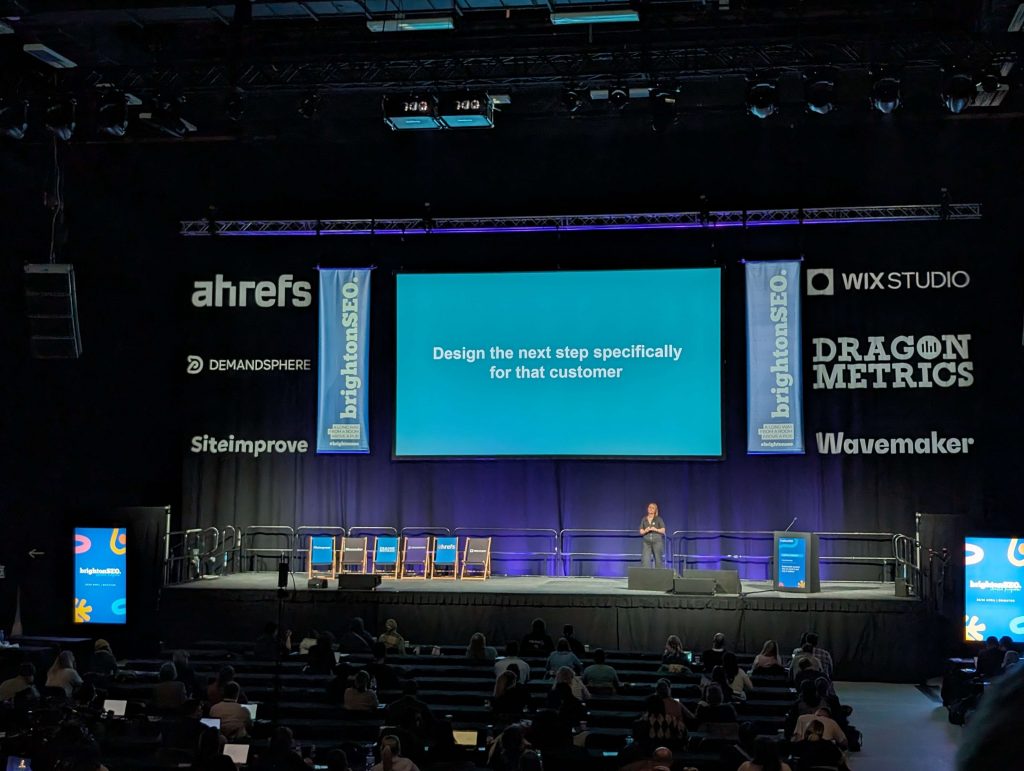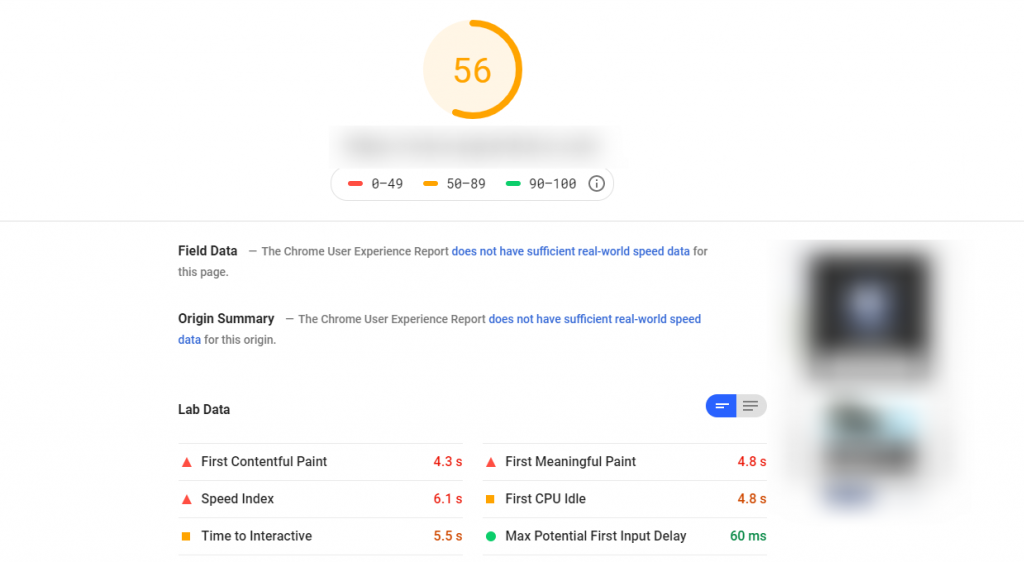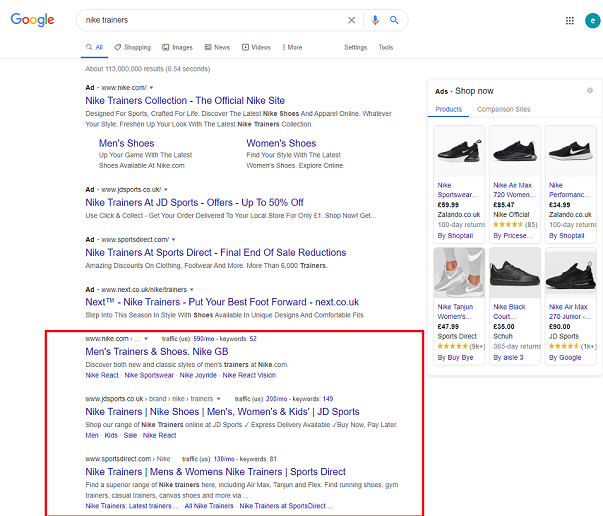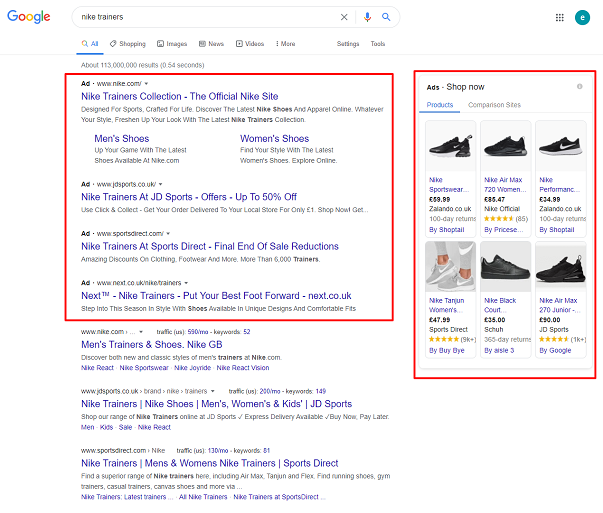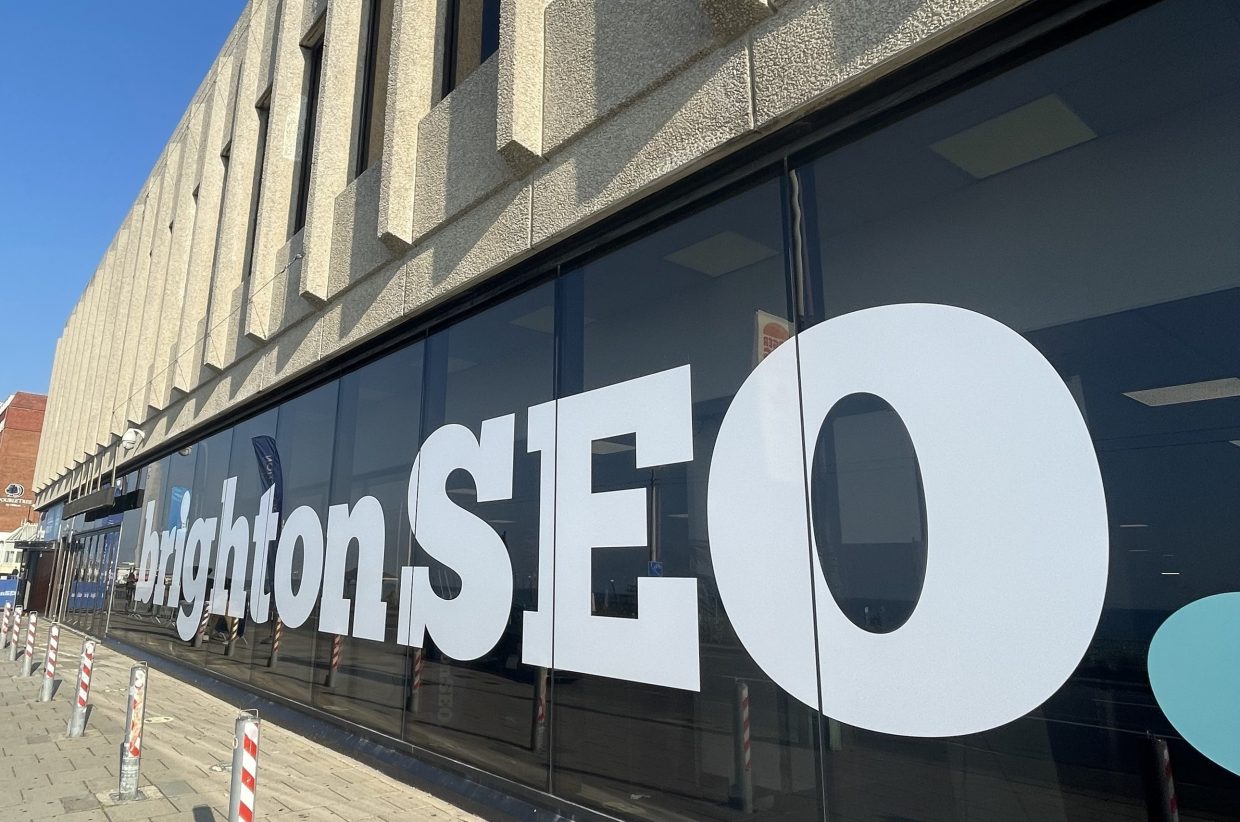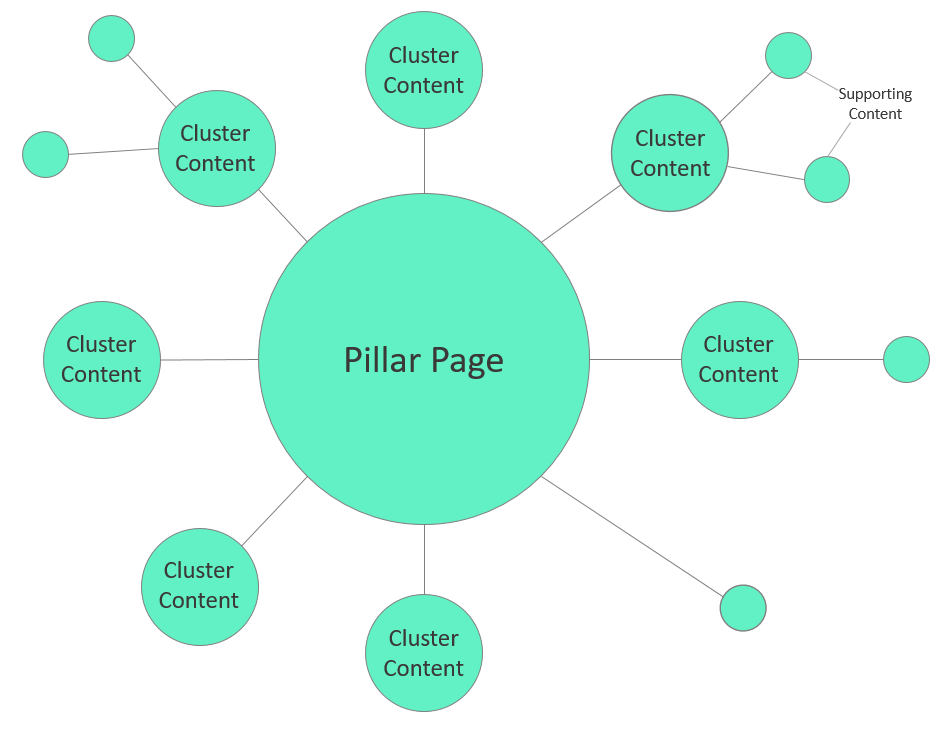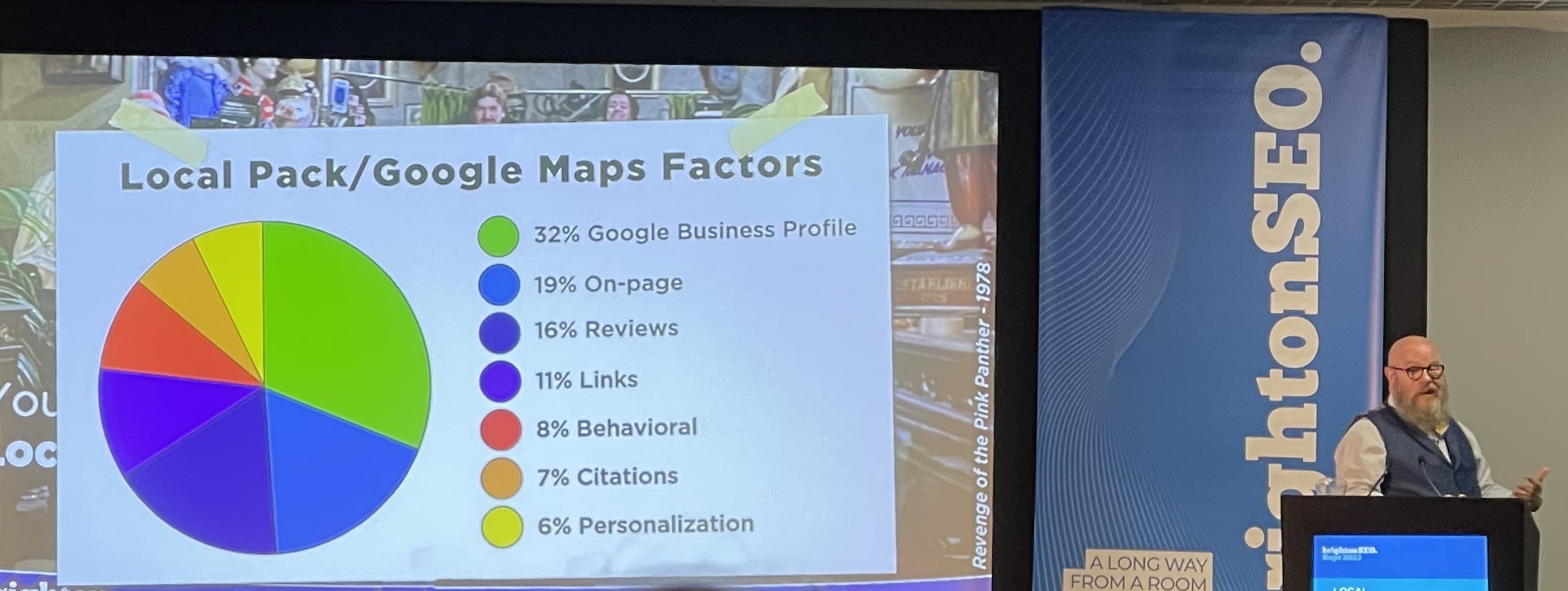How to Set Up a Successful B2B SEO Strategy
Like most things, SEO is always evolving. As search engine algorithms are updated, requirements and boundaries shift to generate helpful results for internet users. In 2024, B2B SEO strategies rely less on content volume and more on user experience, structured data and unique, expert content. We’re updating this blog to reflect the B2B search marketing strategies that work in 2024.
What is B2B SEO?
Search Engine Optimisation is a digital marketing strategy that aims to increase a website’s organic search engine rankings for target keywords. B2B SEO specifically looks for target keywords for which key decision-makers within businesses are searching.
For example, where a B2C (Business to Customer) business selling coffee would seek to rank for terms like ‘best coffee’, ‘ground coffee’, or ‘organic coffee’, a B2B selling to cafes would target keywords such as ‘wholesale coffee beans’, ‘coffee bean supplier’, and so on.
B2B SEO is one of the most sustainable ways of generating leads for B2B companies. At least 70% of decision-makers start their research and buying process with a general search online. Your target customer is finding their new supplier from search engines.
The Difference between B2B & B2C SEO
There is a lot of commonality between B2C & B2B SEO. In both, focus on on-page optimisation, carry out keyword research, build backlinks, improve technical SEO and write SEO-friendly content. Google doesn’t differentiate between B2B and B2C searches, so the ranking factors are the same.
However, B2B has a very different target audience from B2C SEO. A B2B audience is much smaller, has a much higher knowledge of the topic, and have a much narrower demographic.
All this means that the target keywords for B2B SEO have a much lower monthly search volume.
B2B keywords also have high CPC value, because many B2B companies will have more budget to invest in paid search advertising.
-
Understand Your Target Audience
With B2B SEO, figuring out who your target demographics can be a bit more difficult than B2C. It is always easier to plan SEO when you have a good idea of the kind of individual you are targeting. Create a customer persona or profile by answering the following questions about your ideal buyer.
- What industry are they in?
- How big is the business?
- What is their job title?
- How is their job performance measured?
- Who do they report to?
- What level of knowledge will they have on their specific industry?
From this profile, map out some initial ideas for keywords they would search to find your business’s products or services. This can vary a lot from business to business, so it’s difficult to generalise. Keep in mind why this individual needs your businesses to accomplish their goals.
-
Pick the Right Keywords
Build upon your customer profile by going into more depth in your keyword research.
You should aim to meet the following criteria with your target keywords:
- Relevant: The keyword should be relevant to your brand and product/service. Get in the mind frame of a decision maker – what exactly will they be searching to find you?
- Enough Volume: They have enough monthly search volume to make it worth targeting. For B2B, this could be 300, 100 or even 50. Your rates and prices will show how many leads you’ll need to bring value from SEO.
- Reasonable Keyword Difficulty: if the KD is 90, it will take a lot of work to rank for that term. If your budget is low, the KD should be too.
- Manageable Competition: If many companies are bidding for the top paid spaces in search, but you get the top organic spot, you’ve saved money.
Use these points as a guiding principle, rather than hard and fast rules. Collect keywords in a spreadsheet, together with volume, difficulty, CPC and the URL on your website to which the term relates. This will help you classify and review priorities later on.
Tools for Keyword Research
There are many various tools you can use to research keywords, some of which are right there on the results pages. Tools include:
- Google AutoComplete
- Google’s Related Searches
- Google Keyword Planner
- Google Trends
- SEMRush Keyword Tools (Paid)
- AnswerThePublic
- AlsoAsked (Paid)
- Ahrefs Free Keyword Generator
3. Map Keywords to the Buyer’s Journey
Once you have your list of keywords, you can now map them to the different stages of the buyer’s journey.
This is the marketing funnel that we all know so well, but here’s a quick review of the 4 key stages and how they correspond to SEO.
Each search term has a specific intent behind it, and keywords are organised into Informational, Navigational, Commercial & Transactional search intents. We can pair these loosely with the four funnel stages.
Awareness Stage (Search Intent: Informational)
Awareness is the information-gathering stage, where customers are looking to gain general knowledge about a topic in response to a need within their business. This will most likely apply to your broadest keywords.
Landing pages will typically be Blogs, How to Guides, and FAQs. Successful content will focus on how your product/service fits into their business needs at the broadest level.
Interest Stage (Search Intent: Navigational)
The searcher has carried out initial research and now has an idea in mind as to what product/service they need. Their searches will now be more focused, looking for specific product or service keywords.
Landing pages for this stage will be service pages and product pages. Content will need to include specific product/service keywords with as many variations as possible.
Consideration Stage(Search Intent: Commercial)
The searcher has now found the product and service they want and is carrying out further research if there are any better alternatives. They compare price, service, lead times, reviews etc.
To capture interest at this stage, make sure your website displays unique selling points, including an idea of price, third-party reviews and as much information as possible to ensure that a customer will choose you over a competitor. Comparison posts showing directly the differences between products on the market can be a key type of content to target consumers in the consideration stage.
Conversion Stage (Search Intent: Transactional)
The searcher is aware of your product or service, has considered the options and they are ready to make a purchase.
It’s crucial to make product pages and contact forms easy to find so that users can place an order.
For successful B2B SEO, make sure that you have content and landing pages on your website that target keywords at every stage of the buyer’s journey.
If you find that you are lacking keywords for a certain stage, carry out more keyword research to fill in the gaps.
4. Optimise your Product and Service Pages
Once you have your keywords mapped to important pages, you can begin to optimise them. Your main service and product pages are where compelling copy, effective user experience and technical function come together. Use these pages to showcase your product or service to potential customers, and use the keywords that you have mapped to them.
On-Page Optimisation for B2B
For the majority of on-page optimisation, this will be similar to the steps involved in optimising a B2C website. Follow the below checklist to ensure your pages are optimised fully.
- Optimise Meta Data
- Check Keyword Density
- Optimise H1 & H2 tags
- No broken or redirecting internal links
- Pages should have a crawl depth of no more than 3 pages
- Check pages reach adequate Page Speed Scores
- Include internal linking to relevant pages within the body text
- Fix any technical issues.
- Make sure pages are secure with valid SSL certificates.
- Check canonical tags are present and correct.
- Ensure all pages use SEO-friendly URL structure
- Fix any orphaned pages
- All pages should have relevant structured data
- Images are optimised for SEO
- Make sure all pages are mobile-friendly
The main difference between on-page optimisation for B2C and B2B will be the level of specific information in your content.
B2B search users often have a greater level of experience and knowledge about their search than an average B2C customer. Because of this, you will need to finely tailor your content to your audience by including detail and technical information.
5. Tailor your Content to your Audience
In B2B SEO, search users are likely to be very familiar with your industry, even at the information-gathering stage. They will immediately be able to spot a lack of knowledge on your page.
This is why it’s important to regularly check and add to your content, even if the body and structure are written by an agency. Show your expertise.
Every page should clearly state why you stand out within your industry. Demonstrate why someone should choose to work with your business.
A few ways to do this could be:
- Use social proof such as third-party reviews, industry awards and accreditations to provide assurance and build trust with users.
- Have clear CTAs across your landing pages so users know where to go next.
- Be clear about prices. If you can only show a range or starting price, be as accurate as possible.
- Explain exactly how you can help solve their problems.
As well as improving content across your main website pages, you should be looking to build additional helpful content. SEO is no longer about having hundreds of blog posts in the same format. In 2024, your supporting content should be helpful to users, such as FAQs, user manuals, product comparisons and video content.
Supporting content should also include internal links to your key landing pages.
Don’t Forget the Basics of B2B SEO
Following these steps should put you on the right track towards a winning B2B SEO strategy. However, this isn’t something you do once. After this campaign, you need to build upon its success with backlink building, regular site audits, content plans and monthly performance reviews. Maintaining your gains is a key marketing operation, and requires regular upkeep.
If you want to start improving your B2B SEO but don’t have the resources in-house, eSterling can help. We have built hundreds of successful B2B SEO campaigns from the ground up, generating positive returns for a variety of businesses.
Get in touch today to discuss whether we can help you.
SEO Is An Investment, Not A Cost
“How can I justify the cost of SEO?”
“Why should I spend more on SEO?”
“How can I budget for SEO?”
If you consider SEO as a running cost, like power or coffee, you might question what you are paying for. As we like to say, SEO is a marathon, PPC is a sprint. That’s because SEO is an investment, not a cost, and should be considered as such.
SEO clients aren’t paying for a fixed amount of traffic every month: you’re paying for professional time spent on your website. This time builds into a significant and stable ROI as we make changes that support your site to be found and understood by Google.
That’s because a more accurate category for SEO is as an investment.
And a question I always encourage brands to ask is this: “Can you afford not to invest in SEO?”
1. If you’re not ranking, one or more of your competitors is.
How badly do you want to increase your market share and take some of the business your competitors are winning from SEO?
Taking Traffic from Competitors Requires Investment.
2. Unlike paid media, SEO should compound over time.
It might take longer to show an ROI than paid channels, but over a matter of months, those ‘clicks’ and ‘conversions’ become more cost-effective as traffic compounds.
Think longer term and forecast accordingly. 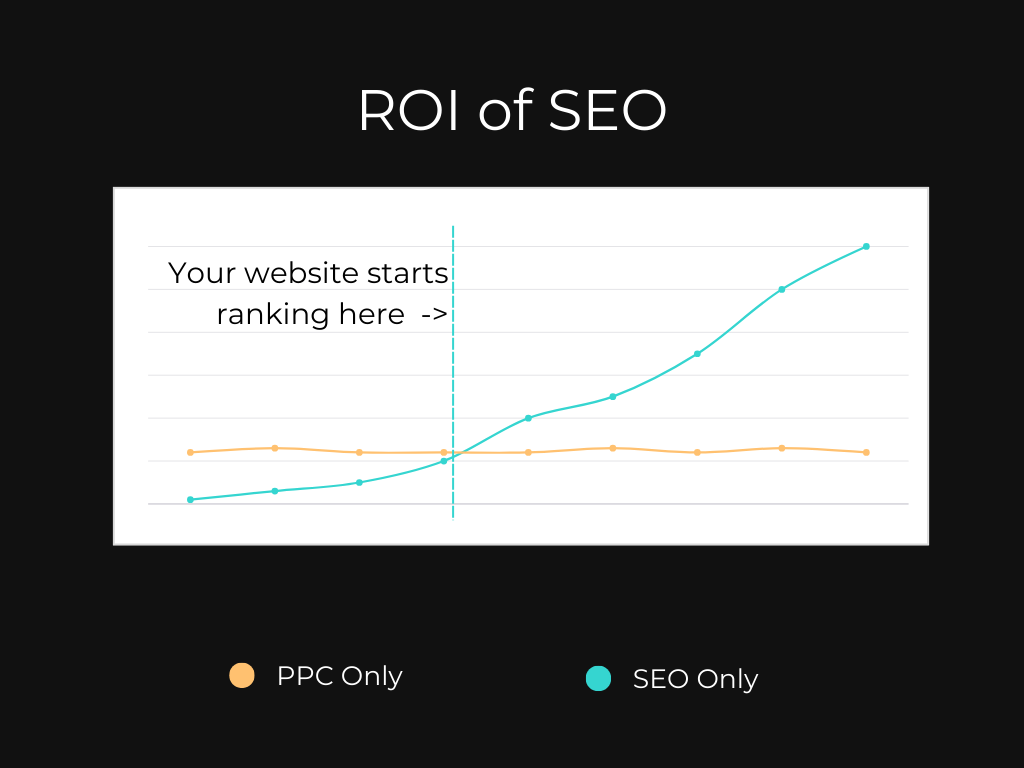
3. Relying on one channel (e.g. PPC) is risky.
When COVID hit, so many businesses wished they’d started investing in SEO sooner. In the early uncertainty, many marketing teams had to pause paid spend on PPC ads.
Those who had invested in SEO as well as PPC still saw traffic, because they had the strong foundation of a properly optimised website.
And that’s without even mentioning the everyday need to diversify traffic sources. A sustainable business model should be able to acquire customers via multiple channels, in case one of them fails.
Diversify your digital marketing.
4. You need to invest at a level that lets you win.
Let us say the quiet part out loud: SEO only gets ROI once your site ranks in traffic-driving positions. You won’t see that return if you’re not investing enough resources to get you there.
Invest to win.
5. Your competitors aren’t standing still.
The longer you wait to invest at a level that lets you win, the further ahead competitors will get.
When you do decide to invest to win, you’ll have more catching up to do.
Invest in SEO: Beginning with a Sitewide SEO Audit
If you’re not getting an ROI from SEO, these are the questions you should ask your current providers:
- What’s the strategy? No, not a list of tactics. A strategy.
- What’s the growth forecast? When will the investment break even and how will the ROI grow over time?
The ROI is only as good as the provider. Long-term gains come from careful, measured approaches. Our digital marketing and SEO team spend time on your site each month, in proportion with your investment, to get you where you need to go.
Get Quality SEO From Today or Read more about our SEO Services.
How to Write Product Page Content for eCommerce Websites
Product pages are often the most important landing pages on your website. Users searching for a specific item will expect to find product pages across organic and paid search results.
Your product pages need to provide the right amount of information for users and search engines. Product pages also get leads from Google Shopping results, so it’s important to get them right. Too much, and the key information will be lost to users. Too little and they won’t be found at all.
Here’s a checklist to help get your product pages up to scratch to perform well in search.
Product Descriptions
All good product descriptions should clearly and concisely explain what the product does, and its benefits over competitors.
Product descriptions should be written for customers first of all.
- Use language familiar to your target customers: no jargon!
- Write with a clear tone of voice, persuasive wording and appropriate length.
- Use bullet points to avoid lengthy paragraphs.
- Include helpful information such as materials used, age restrictions or care instructions.
Descriptions that do this and demonstrate the clear value of your products will be a vital tool for leading your customers through the sales funnel.
As well as writing for potential customers, product copy should target the most relevant keywords that users are searching in Google. Search engine crawlers determine what a product page is trying to sell by scanning and reading the content. If you haven’t included the key terms that most consumers use in your copy and headings, you could be missing out on a lot of search traffic.
- Keywords should be included naturally into the content, and not stuffed in just for the sake of SEO.
- Anticipating alternative phrasing and user questions about your product can help build visibility for a wide range of key terms.
Product descriptions should also be unique for every product. Duplicated content can be a significant issue for SEO and should be avoided when possible, especially for large eCommerce websites.
Product Specifications & Information
Online customers are lazy. When viewing a product page, we want all the information we need up front. Having to click through to other pages to find the details is off-putting. Keep product page content as thorough as possible, with all the information clear and in one place.
Make sure you include:
- Prices
- Shipping costs
- Product size or dimensions
- Colour options
- Technical information
Including as much relevant information as possible is always useful to the customer as they can understand the product completely by viewing one page. This will encourage them to click ‘Add to Basket’ rather than view other options.
Product Images and Videos
Product imagery is the first thing a customer will notice on a product page. Make sure your products’ images look clear, desirable and as high quality as possible.
75% online shoppers have said that product images directly affect their purchasing decisions, so it’s vital to get it right.
Every image should be as high quality as possible while still staying under image size guidelines. Images that are stretched or grainy will instantly send red flags to potential customers, making your site look illegitimate.
Ensure the images are true to the colour of the product. Many people return products because they don’t look how they expected them to, particularly when the products are clothing, footwear or home decor.
A number of images showing your product from different angles is a benefit. It lends authority to your brand, and is especially important for products that appeal because of the aesthetics. Having multiple images for each product variation is also a great way to show your customers exactly what they are buying and increase engagement with the page.
You can also make image helpful, and answer questions your customer may have about a product. Showing products in use, having the ability to zoom in on the image and highlighting features are great ways to level up your product images.
Use image alt text correctly, with a description of the image. This helps users with visual disabilities understand the image, as screen-reader technology reads out the alt text. Search engine crawlers also read descriptive alt text to understand what the page is about, which will help your product page rank for relevant search terms.
Videos are another useful tool for eCommerce sites. Including videos on your product pages offers users a much deeper understanding of a product than a simple image. A video can include voice-over and in-depth product demonstrations. This can be a powerful way of showing why a customer should purchase the product and giving them confidence in what they are buying.
Product Reviews
Social proof is a powerful tool within eCommerce. Seeing what someone else thought of a product can be one of the main things that helps a user decide on making a purchase, and most people check reviews before buying online.
Reviews immediately make your future customers feel much more confident. Display reviews clearly on your product page to increase conversions and get more people to buy your products.
If you need help creating the best product pages possible, get in touch with eSterling. We are experts in eCommerce web design and digital marketing and have the knowledge and tools to help you create product pages that get users to click that buy button!
How to Choose Keywords for SEO in 2024
Targeting and tracking the right keywords brings your site the most relevant traffic possible.
On the surface, choosing keywords for SEO might seem simple. If your website sells shoes, surely it should be as easy as optimising your website around the keyword “shoes”?
Not quite. The single word “shoes” is searched 90,500 times per month on average, and results pages are dominated by big-name retailers such as Office, Schuh and Asos.
It is extremely difficult to compete for the top spot on these general search terms, but keyword research can help find more effective queries to target.
To choose keywords that will be effective for your business, you must do keyword research (or use a keyword research service). During this research, SEO experts consider:
- Search volume
- Relevance to your business
- Competition
- User Search Intent
- Keyword types, such as Long-Tail keywords
Here’s our starting guide for choosing SEO keywords that are best for your website.
What are SEO keywords?
Keywords (sometimes known as search terms or key phrases) are words and phrases that users enter into a search engine to return a set of results.
SEOs use keywords to define web pages and help target content to the largest and most relevant audience possible.
By understanding the keywords that people use to find products and services like yours, you can optimise your website to capture as much relevant search traffic as possible.
Find the right keywords through keyword research.
Search Volume
Search volume is the total number of searches for a given keyword.
For example: according to the latest data, the keyword “star wars” gets an average of 110,000 searches a month in the UK. But how many of those 110,000 are looking for Star Wars toys, merchandise, streaming or just general information about the movies? Judging by the peaks that coincide with release dates in 2005, 2016, 2017 and 2019, it’s information about the movies.
While it is important to target keywords with the highest search volume possible, balance search volume with relevance to your brand and offering.
Keyword Relevance
Relevant traffic will come from users who are looking for the exact information or product your website is providing. They are more likely to buy from you than those who looking for something else.
Although a keyword may have high search volume and low competition, it’s not worth targeting unless it matches the content your website is offering. Otherwise, it won’t bring in useful traffic.
High search volumes often appear for terms with ambiguous intent. Understanding more specific search terms helps you understand the phrases ideal customers are using to find products like yours.
For example: imagine you have an eCommerce site that sells running shoes designed for gym and exercise use.
Tracking and targeting the keyword “shoes” would not be worthwhile. Although it has a high search volume, this keyword is too general and may draw users whose search intent doesn’t match the specific content your page provides.
“Running shoes”, “Gym shoes”, and “shoes for the gym” are all key phrases that have a stronger association with your product.
Research specific terms that describe your product or service well.
Keyword Intent / Search Intent
Understanding why a user is making a search is vital for SEO – are they looking for a specific product? Do they just need some information on an event? Are they looking for contact details?
There are four types of searches (according to Google)
Navigational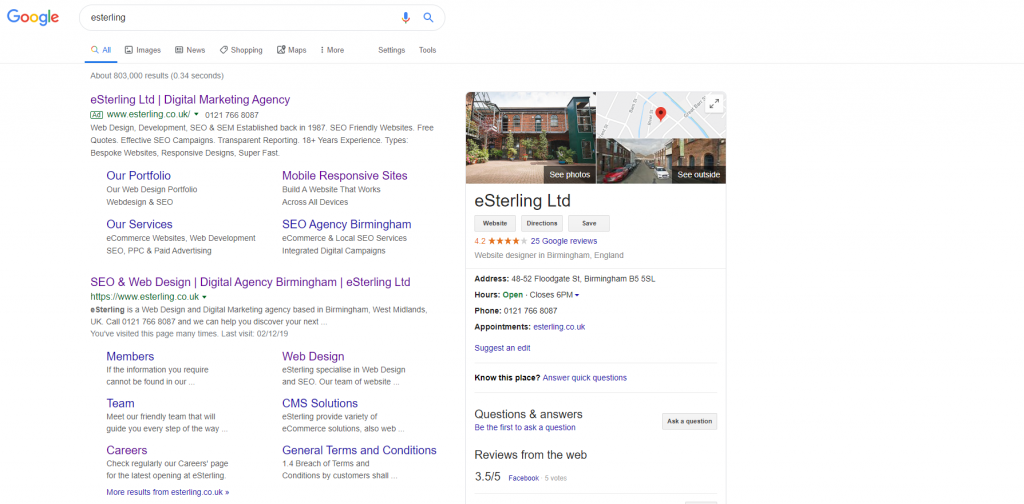
The intent is to reach a particular website or brand. Navigational searches could be terms such as “amazon” or “nike running shoes”.
Informational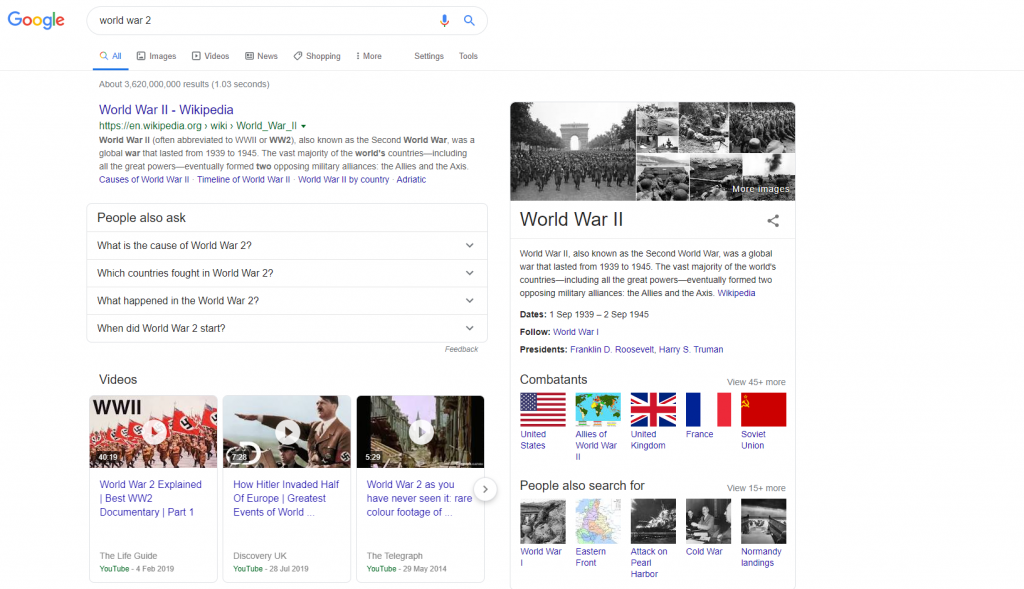
Informational searches are when users are looking for guidance, background information, or specific information about a topic or product without having any concrete intention to purchase or any wish to seek out a specific page.
Transactional
Search requests that indicate a clear intention to purchase are regarded as transactional queries.
Commercial
This is a more recent addition, and describes search terms used by those who want to compare different options before making a purchase.
Commercial search term users are higher up the customer journey funnel than those using ‘Transactional’ search terms, so these queries often return comparison articles, reviews and testimonials.
Through machine learning, Google attempts to understand the intent of searches and returns results that are the closest match to this intent. By looking at the results for a certain keyword, you can get an idea of what a user’s intentions are when they use it.
This is important when choosing keywords. Commercial and Transactional search terms are worth targeting and tracking to increase business.
Keyword Competition
It’s important to consider which competitors are appearing for your chosen keywords. If the first page of Google is dominated by Amazon, eBay or equally as large companies, it may be difficult to outrank these sites.
This isn’t to say it’s impossible but, especially in the early days of an SEO campaign, it may be better to focus your efforts on less competitive keywords.
Research similar-sized competitors and see what keywords generate organic traffic for them. Do you rank for these keywords?
Long-Tail Keywords
Long-tail keywords are longer, specific phrases that narrow down the pool of results.
They are less competitive than shorter keywords, and although they have lower search volume, those using them are more likely to convert to purchase than those using shorter terms.
While your main pages should target simple, high-volume terms that match your products, long-tail keywords provide quality traffic that is extremely relevant. They also help you stand out from your competitors who are only targeting generic shorter terms.
To return to our example of the eCommerce running shoes site, examples of long-tail keywords would include:
- “Running shoes for gym size 5”
- “Ladies black running shoes”
- “Good workout shoes for the gym”
- “Trainers for weightlifting and cardio”
Target long-tail keywords with subheadings on your main pages or content in your blog section.
If you are still having trouble choosing the best SEO keywords, contact eSterling.
As part of our SEO services, we use industry-leading keyword research tools to uncover exactly what you need to target to bring in the most traffic possible.
Give us a call on 0121 766 8087 to discuss how we can help your website reach more people.
BrightonSEO Lessons: Content Strategy in 2024
Our team travelled to Brighton for the biggest SEO conference in the world: BrightonSEO. It’s come a long way from a room above a pub, they say…
Because of the sheer quantity of talks, tips and strategies shared at this event, we can’t include everything. This is the first blog in a new series which will cover the most interesting insights, organised by topic. First, we’ll look at content strategy.
What kind of content will you focus on? How much of it will you produce? Across which platforms? How will you measure success?
A good content strategy is:
- Informed by current content performance
- Targeted using audience profiles
- Time-bound and Measurable
New Thinking on Content Strategy
With the launch of Google SGE coming this month, and search intent forming a much bigger part of the picture than in previous years, there is a lot to discuss this year. The main question on our minds was:
“How do we plan content that creates resilient organic traffic for our clients during all this change?”
Three speakers in the Content Strategy session had different takes on what SEO content writers should prioritise.
1. Preparing for Google SGE
Anna Morrish of Quibble shared content strategies for AI-integrated search. Google SGE will show AI-generated answers before organic website results. As a result, SEO’s are currently analysing how to mitigate losses in organic traffic, which Morrish says may drop by 20-60% in May 2024.
From analysing results during the SGE trial period, Morrish suggests the main areas to focus on will be category content and Google reviews. These are the main decision-making areas that are summarised by SGE, with links to information sources included in the answers.
Using ‘labyrinth movie gifts’ as a sample search query, Morrish demonstrated that SGE will suggest various expansions of the query by category. If category content on eCommerce sites lists helpful information that other providers don’t, the SGE may list your categories over others and cite your website as a source.
She also showed that local business reviews appear as a summary in Google SGE. Like category content, if your Google Reviews include specific language about services, the SGE experience will be more effective.
We’re looking at the questions audiences are asking about our clients’ products and services to understand content gaps and create content to fill them.
Research from STAT (Moz) points to a net benefit for SEOs. The data suggests that users in the US rarely see SGE results by default. Instead, they are triggered by “Generate” buttons, giving users control.
This means the top 5 results will not be completely obscured by the “Generate” button, so your high-ranking pages will still have value.
They also found that sites referenced in 55% of SGE results “did not actually appear in the top 10 organic results for the same SERP.” As we know from the introduction of Featured Snippets and People Also Asked, search users look around for context, even when Google is feeding them key information directly. Lower-ranking pages with specific and useful information may still gain clicks as citations in the SGE’s references.
3 key tips to prepare websites for Google SGE:
Here’s how we can make sure websites are ready for this AI integration and minimise drops in organic traffic.
- Keep content short and to the point.
- Make it personal where possible
- Encourage specific reviews for local businesses
The introduction of AI content isn’t necessarily going to cause a huge shift in metrics. SGE will only appear for users who log into a Google account in their browser, and won’t necessarily show up automatically. This feature is not yet available to more than a ‘small slice’ of UK users, so stay tuned for more detail as the roll-out progresses this month.
2. Target Users who are Ready to Buy with Comparison Posts
Araminta Robertson of Mint Studios shared data on real content that mentions competitors without directing traffic away. Conventional wisdom has been that writing about competitors will simply make users aware of other options and potentially lose sales. Robertson skewers this logic as old-fashioned.
“Customers already know about your competitors” she says, and backs it up:
- They’re doing 3x the research they were doing in the 2010s
- They’re seeing targeted ads the second they start searching for products like yours
- With smartphones, searching multiple sites and products at once is quicker and easier.
Robertson’s rationale for prioritising comparisons was convincing: Comparison posts double conversion rates, and double the size of the deals they lead to. 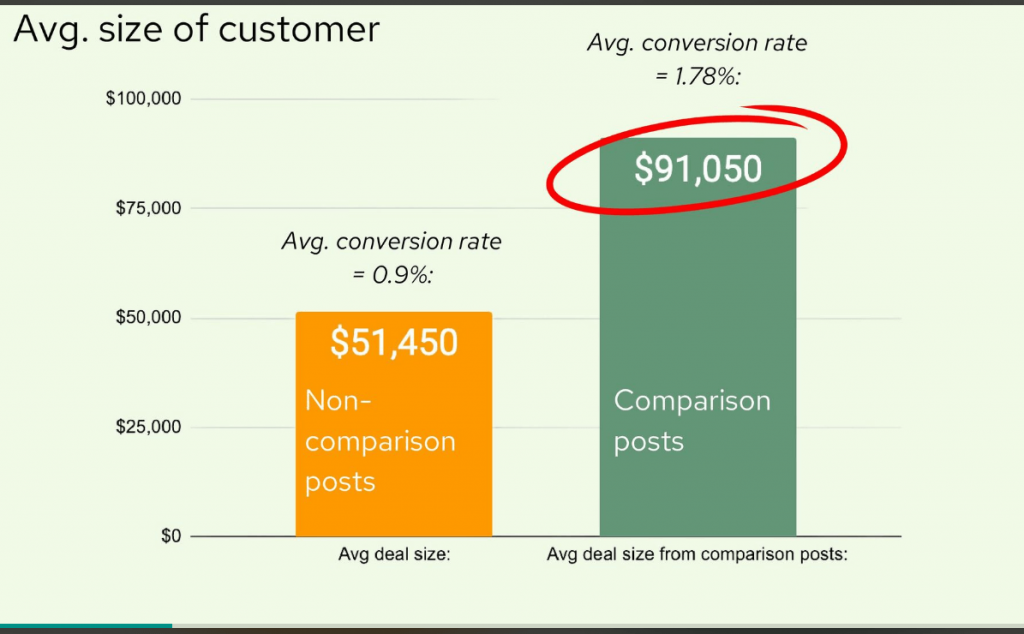
This is because comparing your solution to your competitors’ targets people who are ready to buy. At this funnel stage, people crave comparisons, as shown by the success of sites like Compare the Market.
Why does this work?
Giving potential buyers a direct comparison between your product and a competitor’s alternative saves them time and cognitive energy.
“You don’t want to write an article that says “Our product is the best” full stop.”
The key is to show the situation in which your solution is best. Robertson suggests structuring the article into three parts.
- First, make a solid case for your product. Use technical details, the problems it solves, and testimonials to show why this product works for the situation.
- Give the straightforward facts of a competitor’s product. You can avoid being overly negative or critical, and you can show the situations in which these products might surpass your own.
- Do the same for a third competitor. Give just the facts.
To Make Comparison Posts Work: Name the Elephant
Robertson also advised writers to build trust with the reader by “naming the elephant in the room”: bias.
By being up-front and acknowledging that we think our product is the best, we can disarm the reader’s cynicism. This helps them assess the products with more openness and presents your brand as honest and down to earth.
3. Sustainable Content is Better SEO
Fiona Brennan of Indie Essentials broke the silence on the environmental impact of server farms. To sustain the internet as it is, with 15 million pieces of content (or 328.77 million terabytes of data) generated daily, millions of servers are running day and night. This uses energy and creates an enormous carbon footprint.
Brennan argued that creating huge volumes of content on every conceivable channel is also unsustainable in human terms, sharing that 50% of content writers are burnt out.
The solution to both of these issues is to create less. Instead:
- Optimise existing content. Use what you have before creating more.
- Improve CRO to make the pages that perform well bring people to the products.
- Reduce your channels to include only the channels that make sense for your target market.
- Don’t be afraid to pivot future messaging towards the audience you’re gaining, rather than trying to target everyone.
We already know that with content, less is more. It’s with gratitude that we share Brennan’s approach as a people-first strategy for content creators as well as internet users.
Content Strategy is Changing: for the better.
We’re relieved, frankly, that SEO content doesn’t need to be long-form, rehashing existing information or produced ad infinitum anymore. It’s exhausting, for content writers and SEOs alike. The new content strategy ushered in by the Helpful Content Update, SGE and anti-spam policies favours lean, specific and informative writing.
When we rewrite content for a client’s website, we start with a content audit. By creating an inventory and analysing each page, we can prioritise high-value pages that need work. Out-of-date, irrelevant pages, such as old blog posts, can be pruned or updated, and any new content is as lean as possible.
A few years ago, the conventional wisdom was to add as much content as possible. This means most websites that have had SEO in the past may need to reduce and distil the information they display to continue seeing good results.
If your website’s rankings have been declining, get in touch for an SEO audit with eSterling.
How to Improve Page Speed (and Why it’s Important)
Improved Page speed has been a direct ranking factor for Google since 2010, and it’s only become more important.
On both desktop and mobile, faster-loading websites are more likely to rank highly on SERPs than slower pages with similar content.
Simply put, page speed is important because a slow website can hurt your search engine rankings and reduce traffic.
What is page speed?
Page speed, in its simplest terms, can be defined as the time it takes for a website page to load.
Page speed can have a few definitions, but the definition Google uses is made up of 3 metrics: first contentful paint, largest contentful paint and cumulative layout shift.
First contentful paint (FCP): the time it takes to load the first element of any content on a page. This includes images, text, header bars or canvas elements.
Largest contentful paint (LCP): the time it takes to load the main content of the page.
Cumulative layout shift (CLS): a measure of how much the page layout shifts during browsing, such as if the banner loads and pushes text down the page while the user is reading it.
Google uses these metrics to generate their page speed score – which you can test with Google’s PageSpeed Insights.
Faster Loading Speed = Better User Experience
The impact of page speed on search rankings isn’t automatic. A fast page has a better chance of reaching the top 3 than a slow page with similar content. This is because fast loading indicates a better experience for the user, and that is the ranking factor.
Faster Loading Speed = Cheaper AdWords Bidding
Speed also has an impact on PPC performance, as a slower site can also decrease your Google AdWords Quality Score. A lower quality score makes it more difficult and more expensive to bid for the top positions in Google’s paid results, so it’s worth optimising your page to make your budget go further.
Faster Page Speed Reduces Bounce Rates And Increases Conversions
A faster LCP reassures users that the page is useful and easy to navigate. It’s not useful to rank No.1 if users then struggle to navigate.
A slow site is difficult to use, which you’ll know if you’ve ever had to try and click through a site which takes more than 5 seconds to load. People lose patience quickly because websites are supposed to flow seamlessly.
The impact of this is magnified on mobile:
According to Google Consumer Insights, 53% of mobile visitors leave a page if it takes more than 3 seconds to load.
Slow pages increase your bounce rate and lower your conversion rate considerably, particularly if you are an eCommerce site. The opposite is also true.
Fast loading times keep users engaged, meaning they stay on your site longer and are more likely to complete the customer journey.
For instance, in 2019, eBay ran a companywide push to optimise speeds on all pages. For every improvement of just 100 milliseconds in search page loading time, eBay saw a 0.5% increase in their “Add to Cart” count.
To Improve Page Speed, Minimise HTTP Requests
To speed up loading times, remove unnecessary elements that can bog down the browser. This may be more complicated than it sounds, depending on how your site has been built.
HTTP requests occur when a browser requests files from the website’s server to load the websites. The server sends the files, the browser downloads them and the user can interact with the website.
While this happens relatively quickly, the browser can only retrieve one asset at a time.
The more files required, and the larger they are, the longer this takes.
Fewer and smaller files mean websites load faster.
1. Minify & Combine Files
You can easily combine multiple CSS and Javascript files to reduce the quantity. However, this just makes one big source code file, which may take equally long to load.
Minification optimises your source codes to make them as lean as possible. Removing all unnecessary characters, such as white space, comments and readability data, makes the file smaller.
Minifying source code is a function of many website themes and caching plugins, but if your website is not so straightforward you may need to contact a developer.
3. Enable Compression
Compression is a method of reducing file sizes to retain necessary data without slowing things down. High-resolution image files are a good example that we often find on slower sites. Images compress easily, reducing the bandwidth required for loading without noticeably reducing the image quality.
By enabling page compression in the backend of your website, you should see a good reduction in LCP speed.
4. Enable Browser Caching
Rather than repeatedly requesting the same files from the server, browsers cache important data from websites they have visited before. This means they keep some documents locally so that when the file is requested it can load immediately.
If your website does not allow browsers to cache, your page speed and your user’s experience suffer.
5. Disable Unnecessary Plugins
If you’re using a website builder such as WordPress, your website probably has some Plugins to help it function. However, not all Plugins are necessary. Browsers have no way of knowing whether a Plugin is necessary or not, so they request and download everything to load the page.
By disabling the Plugins you don’t need, you reduce HTTP requests significantly and speed up the web page loading speed.
Every website is different, so diagnosing speed issues properly requires the knowledge of a skilled web designer or developer.
There are always more ways to optimise page speed, but these methods are good places to start.
The team at eSterling can help you improve your page speed, so come and talk with our expert designers and developers. We have the knowledge and skills to quickly identify any issues preventing your site from loading at the optimal speed.
If your site is scoring low on Google Page Speed Insights, call eSterling now on 0121 766 8087. We’re happy to advise on improving your site’s performance.
SEO vs PPC: Which is Better for My Business in 2024?
When putting together your digital marketing budget, one key decision is whether to invest in PPC (pay-per-click) ads, SEO (search engine optimisation) or both. Comparing SEO vs PPC concerning your business needs can give a clear picture of what will and won’t create the desired results.
Ideally, the most effective strategy is to invest in a combined PPC and SEO campaign. The two work well together to help you dominate search results in the long term, gaining customers from your competition. However, the reality of marketing budgets may limit your strategy to just one of the two.
This guide will define SEO vs PPC and give you the pros and cons to help you decide which will best fit your marketing goals.
What is SEO?
Search engine optimisation (SEO) is an ongoing process of amending your website and pages to communicate with search engines more clearly than your competitors. This process helps your website and pages appear in the top organic search results for relevant queries.
Organic rankings are search results that can’t be changed by paid advertising.
Search engines rank organic search results according to their relevance to the search term. Rather than paid advertising, SEO puts your brand at the top of the search results more organically: with mobile and load-time-friendly sites that showcase their products and services to both Google bots (which crawl your website) and users. Ensuring your website is user-friendly with useful information and few technical errors is a key requirement for a well-optimised website.
On-page SEO
One piece of the SEO puzzle is on-page SEO, which focuses on the elements shown on the front end of the website. There are many factors to on-page SEO. With the recent helpful information update, rolling out on-page SEO is more important than ever.
These on-page factors are where keywords come into play, and we can place keywords strategically to give search engine crawlers the clearest picture of what the page is about. These include:
- Content: High-quality, original and helpful content, always gains organic keywords, so the keywords gained must be relevant to your ideal customers.
- Headings: Breaking up content with headers makes it easy to scan and understand, helping people stay on your page longer. This helps at the consideration stage of the consumer funnel.
- Meta tags and descriptions: These appear in SERPs to give more information about the page, but they also tell search engine crawlers how to index your page.
- Images and Alt Text: Ensure your images are high quality, in the right format and named with keywords.
- Site structure: Pages should fit together in a logical, easily navigated way, for both users and search algorithms.
- Internal Linking: Including links between key parts of your website helps user navigation and search.
Getting the balance between user-friendliness and search optimisation is the key to high-ranking pages. Google’s Helpful Content Update(August 18th 2022) has changed the way SEO works when it comes to content. You can’t simply rewrite other people’s articles, or use AI extensively because Google won’t rank it. For great on-page SEO, a specific target audience can help create content that works to bring in quality traffic, using the keywords your audience uses and focusing on the problems they want to solve.
Off-page SEO
This is the secret sauce of SEO – focussed on building your website’s authority and credibility beyond content and site structure. This is how a search engine determines whether your website is worth ranking highly for keywords where there is high competition.
Off-page elements include:
- Backlinks and referring domains: quality links from reputable websites show that your website is a valuable source of information.
- Content marketing and social media engagement: sharing your content on a range of platforms encourages others to link to your website and builds up your rankings indirectly.
While there are fewer parts in off-page SEO, this key phase is just as challenging and requires a professional understanding of industry publications, audience management and social media.
In this way, a good SEO strategy provides a firm foundation for marketing, building your brand reputation as well as your search rankings. This makes SEO a powerful marketing technique for long-term results.
Pros of SEO
Low Cost: SEO is generally a lot more cost-effective than other forms of digital marketing, in particular PPC and Google Ads. You don’t pay for people to click on links to your website when you rank organically. SEO provides big opportunities for a great ROI in the long term.
Scalable: Once you have gained first-page rankings for high-volume keywords, you can build on this success and look at other areas to target. Good performance in SEO provides a great foundation for further digital marketing strategies provided you have the right strategy.
Higher Click-Through Ratio: Generally, users will be more likely to click on organic results than paid results, which many people ignore.
Branding: Aside from more traffic, high search rankings give your business and brand more visibility online. Many users trust organic results more than ads, and you can quickly build a reputation as a leading provider of a product or service if you rank highly for several keywords. The quality of the website, content and backlinks that are required for high search rankings have knock-on effects on your overall brand reputation. Your site appearing first can influence your perceived credibility with an audience looking for your product service.
Sustainability: Once you have achieved high rankings and have an ongoing SEO strategy in place, your competitors can’t simply outbid you to appear higher up. They will need to invest a lot of time in developing their site to knock you off the top spot.
Find out more about our strategies for SEO or contact us to talk it through.
Cons of SEO
Long Term:Results from SEO can sometimes take 3-6 months to generate results. If you only have a short window to see returns from your marketing, SEO may not be the best option. However, once your website has gained a significant ranking for high-volume key terms, this is fairly easy to maintain, bringing traffic to your site for the foreseeable future.
Not always viable: For the majority of businesses, SEO is an invaluable tool in their marketing arsenal. However, a small number of companies may not see the same benefits; their industry is too competitive in search or their product/services just don’t get enough search volume.
What is PPC?
Pay-per-click (PPC) is an advertising model where your website pages are displayed at the top of search results, marked as ‘sponsored’ or ‘advertising’. Google displays your ads with a link to
your website, and you only pay when a user clicks through to your site. This is typically associated with search engine advertising like Google Ads or Google Shopping.
A Strategic Approach for Google Ads
When creating a Google Ads campaign, we start with keyword research and organise the terms you want to target into the ad groups that will sit in your campaign. Once the campaign is live, you can manage this with a daily budget and set a cost-per-click limit, which stops the cost from spiralling. Your account will start spending money once a user searches and clicks on your ad.
We recommend starting at a lower budget for the first month or so, as your campaign will be in “learning mode” for the first six weeks. This means that Google is learning about the users searching for your ads, feeding into an algorithm to help Google determine if the user is in the awareness or consideration stage.
Once you start to receive conversions, you can either choose to focus on increasing conversions or traffic to your site.
Choose Your Keywords
With Google Ads, you are in complete control of what keywords your website shows up for on Google. There are three types of match types: broad, phrase and exact.
Broad: Shows your ad to searches that are relevant to your keyword
Phrase: Shows your ad to searches that include your keyword
Exact: Shows your ad to only those searches that are an exact match to your keyword
You need to ensure that you are keeping on top of your search terms with your campaigns. Removing any irrelevant keywords into a negative keyword list helps keep your campaign working effectively. You can find out more information on Google Ads management online here.
Pros of PPC
Quick Results: PPC can generate traffic results much faster than SEO. PPC can take 6-8 weeks to show measurable results, which makes it a good choice for businesses that need short-term results and a quick ROI.
Position on Results Page: Google Ads now take up a large portion of search result pages, generally in the first four positions. Although users tend to click on organic results more often, being able to occupy the top of a results page for your chosen keyword can be a massive boost to both traffic and authority.
More Specific Targeting: With PPC ads you can filter the users you target based on age, location and demographics. You can make sure you are only paying for the traffic that you want on your website.
Range of Channels Available: Google Shopping Ads, Display Ads and Text Ads are all forms of PPC advertising. Investing in PPC marketing gives you the option of trying these channels and seeing what works for your business.
Find out how our team use PPC & Adwords for fast traffic boosts.
Cons of PPC
Can Be Costly: Depending on the competition in your industry, PPC can be expensive. Extremely competitive industries such as Law Services or Insurance can have very high costs per click. Keep this in mind if your marketing budget is tightly controlled.
Higher Initial Investment: Although PPC can get results immediately, to optimise your account you need a lot of data on clicks and conversions. This means that initially, your initial cost per conversion will be higher than it will be once the campaign has progressed and begun to generate data. You will need to be realistic about how long it takes to optimise a PPC campaign.
Is SEO or PPC right for my business?
This will largely depend on your industry and business and you will need to weigh up the above pros and cons and see how they fit in with your business.
SEO is low-cost, long-term brand building that helps your website perform at the best possible level.
PPC is a variable-cost, high-impact option that quickly builds awareness and traffic to your site, but may not be sustainable long term.
What we find at eSterling is that you can mitigate the cons of SEO with good PPC and the cons of PPC with good SEO. For example, a PPC campaign can plug the gap between starting SEO and seeing lasting results. Marketers will need to weigh up all of this against business needs and goals.
Questions to ask to decide between PPC vs SEO
These questions will show you the way: SEO, PPC or Both?
Do you need quick results?
If you want to increase traffic and sales immediately, PPC might be the right direction. PPC allows you to drive targeted traffic towards specific pages on your site. Before you start with your Google Ads journey, you should make sure the landing page is set up for conversion tracking and have relevant information to help users convert.
Is competition for organic search results high in your industry?
Using tools like SEMrush, we can measure the relative competitiveness of each keyword in your industry and establish the likelihood of ranking organically with your current domain authority and backlink profile.
If most of the keywords relating to your products or services are highly competitive, SEO may take a long time to have an impact. This is because we will need to focus on building overall domain authority. A PPC campaign can fill the gap before an SEO campaign creates results.
What are competitors paying for ads?
Using the keyword planner tool on Google Ads, you can see the average cost-per-click (CPC) to be at the top or bottom of search results. This gives you an idea of how much you will be paying per click. You can set a maximum cost-per-click budget on each campaign or bid manually, which will give you complete freedom to ensure each keyword has an individual budget. Manual cost-per-clicks is recommended for small campaigns only.
You can also get an idea of how much competitors are paying monthly on SEMrush by viewing their organic and paid search results. This is a rough estimate and not 100% accurate but it can be helpful to figure out how much you should be spending a month. If your competitors are paying huge amounts, PPC may not be the most cost-effective strategy and you may be better off with SEO.
How much is your digital marketing budget?
Comparing SEO vs PPC for your business also depends on your own marketing budget and the competitiveness of the keywords you are looking to target. For PPC, we always suggest that you start small and increase your budget slowly over the first three months of running your campaigns. £500 a month is the best starting point for most industries, it gives you the flexibility to trial your keywords at a reasonable price while allowing Google’s algorithm to direct users to your ads.
As for the first month or so Google is in learning mode, you may find a lot of budget is going to waste through irrelevant searches, so start small and making sure you are keep on top of your negative keyword lists. Having the correct conversion tracking set up is key so you can analyse which keywords are gaining sales. You should only consider spending more on PPC once you have results, and then reviewing what your monthly budget should be.
Comparatively, strong SEO may be more cost-effective than PPC, because you can reach the top of the search results for terms that are expensive when targeted for paid ads. Given that most users prefer organic search results over ads, you can gain traffic without paying for clicks.
We Can Help You Choose
If you are still unsure about what direction to take your digital marketing campaigns in, eSterling can help.
Our dedicated marketing are experts in both SEO vs PPC campaigns. We can offer free advice on what is best for your business to guide you to the channels that will get you the best return on your investment.
Contact the eSterling team now and we will be happy to help with any questions you might have.
11+ SEO Tips We Picked Up at BrightonSEO 2023
On September 15, 2023, two of our SEOs and a content writer travelled to Brighton for a conference that specialises in search, social and content optimisation. I know, it was over a month ago, but sometimes that’s how long it takes to unpack a suitcase full of lessons. We’ve had a chance to put these SEO tips into practice, and we’re ready to share the most useful and intriguing lessons from BrightonSEO 2023.
What is BrightonSEO?
BrightonSEO is the foremost search marketing conference worldwide, hosted in the UK and the US. It brings together speakers from all over the world to share SEO best practices, the latest in content marketing and discussions on search metrics and social media.
“It’s a chance for SEOs to meet, learn and do their job a little better.”
– BrightonSEO
Find out more about how we use SEO at eSterling.
SEO Lessons from BrightonSEO ’23
We would love to share every little thing we learned, but that would be:
- Extremely long
- Time-consuming
- Not as good as just attending the conference yourself
Instead, we’ll continue adding to this article until we have created a full SEO Guide, so watch this space!
These are tips from some incredible people in search marketing, so we’re not looking to plagiarise – you’ll find links to their slide decks in this article so you can get the full picture.
To help you find the advice most relevant to your website, we’ve sorted these tips into two categories: Basic SEO, Content and Local SEO.
Basic SEO Tips
We already know that site-wide strategies work much faster than single-page or single-keyword strategies. And we know that Meta-titles are important. This lesson is more of a reminder to us, but we’re including it because it might be new to you.
Quick Wins
These are the first jobs in any SEO strategy, those which take minimal effort but have a high value. Thanks to Andy Mollison‘s presentation, our SEO team are up to date on the low-hanging fruit to gather early on in the strategy.
Meta Titles
The growth rate for sales from organic traffic can increase rapidly just from templating meta titles. These are the titles that show up on SERPs, which are not necessarily the same as the headings on the page itself.
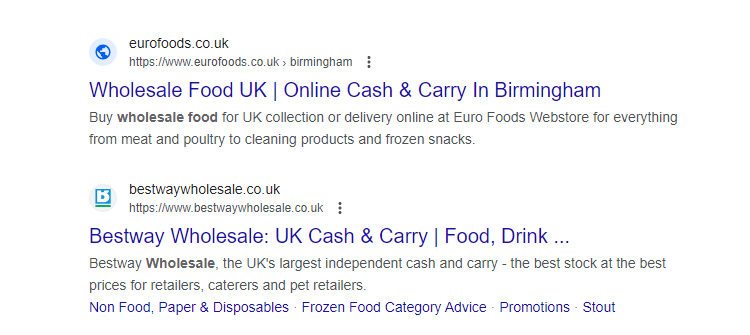
Meta titles should be specific and relate to the most relevant search queries for the product. For example, if you’re a food wholesaler, you should include ‘Wholesale’ in your meta titles.
For eCommerce websites, you can gain a huge amount of organic traffic by making it clear that customers can buy online in the meta title. This differentiates your page from a brochure website or magazine articles about the product type and reaches people looking to make a purchase right then and there.
Image compression
Making sure all your images are high quality is great, but if the files are enormous they’re going to slow down the site and leave pages lagging behind in the SERPs too. On top of this, slower loading means people navigate away to find a faster solution, so it’s worth compressing images.
Sitewide image compression is possible with WordPress plug-ins such as TinyPNG, and there are plenty of online tools available to support lossless compression and optimise your images.
Image Alt Tags
Use alt tags to help explain to Google what your pages are about. It’s a common practice to add keywords here, but a mistake some make is to paste the same keyword to each image regardless of what is shown.
Alt tags are also used to make your website accessible to users using screen readers. Even if you’re using stock imagery to highlight how stress-free life could be without your product, the alt tag should reflect this. SEO Best practice is to use keywords and relevance in your alt tag descriptions.
Internal Links
Internal links were a key topic at BrightonSEO this year. Julien Deneuville and J. M. Felip discussed methods for ‘wrangling’ internal links on huge sites, while Martin Hayman described how we can build internal links using Topic Clusters (more on this later).
Internal links within your site do three things:
- Help search engines find all of your pages and understand which ones are most important
- Pass authority between pages on your site
- Help users navigate to the most important pages for them
Internal links can often be found in the site navigation, a useful links section in your page footer, or in a sidebar highlighting similar pages. However, according to J.M. Felip, an SEO strategy should prioritise the links in the main section of your page.
These in-context links lead to relevant and related information, helping your users find related content quickly and helping Google’s crawlers understand the relationships between your pages.
Our Digital Marketing team provide Organic SEO and eCommerce SEO services to businesses of all sizes. Contact us today to discuss an SEO strategy for your website.
SEO Content
We’ve heard so many times that ‘Content is King’ and, as a content writer, I have to agree: nothing does more for a page than content. However, just adding a blog post every week or stuffing your pages full of keywords is a rubbish strategy that won’t get you anywhere.
Content for content’s sake is not the point. What SEO’s mean when we say ‘Content is King’ is that the sites with the most comprehensive, readable, well-linked content on a topic overall will rank more highly than a single page that vaguely skirts around the edges of the subject, without relevance to the rest of the site.
The point of a search engine is to help users find what they’re looking for online. The point of content is to answer queries. Good content will signal to the search engine that this website is a trustworthy source.
But how do you create content that stands out in a saturated online space?
Highlight your topical authority.
Content Clusters Put Information Front And Centre
Content clusters or topic clusters have been a great SEO content strategy since around 2016 when Google’s search algorithm began to favour topic-based content. The idea of topic clusters is to link related content together around a central ‘pillar page’. This creates a user-friendly structure and a search-friendly system that can easily be crawled and indexed.
The reason for using this strategy is to strengthen Topical Authority. Every domain is given an Authority score, based on how trustworthy the website appears to search engine algorithms. With quality content, internal links and backlinks, a website can gain high authority and thus, high rankings.
Related content can be internal or external, including blog posts, social pages, guest blogs and site pages. However, creating a chaotic web of links between all of your existing content on a particular subject can become unmanageable and difficult to navigate from a consumer mindset. This is where Pillar Pages come in, and I was lucky enough to get a refresher on this subject from Martin Hayman, author of The Organic Advantage at BrightonSEO this year.
Pillar Pages can be Short or Long
Also called keystone pages, core pages or cornerstone pages, this is the central hub to organise all your topic content around. A good pillar page will:
- Summarise the topic adequately
- Contain links to all cluster pages
- Be easily found on the main website.
Sub-topics
Around each pillar, high-authority sites have sub-topic “cluster” pages. These go into greater depth on particular aspects of the topic.
Sub-topics might be instructions for use, benefits of a product, comparisons with other topics, use cases, and so on.
Link each cluster page to the central pillar, and to other cluster pages. As you add more sub-topics, you should update the pillar page with a relevant link, so that users can navigate up or down the chain, zooming in and out of the subject.
Supporting Content
Hayman also recommends creating supporting content, blog posts that are relevant to the topic, social media posts, and so on. These provide an extra layer of internal and external links to bolster the cluster as a whole. They can link to the pillar page, cluster pages and each other, creating a network of information with the pillar page at the top.
To make pillar pages and content clusters work for your website, the key is to build internal links between them. This strategy gives a good structure for high numbers of internal links, but a scatter-gun approach is ill-advised.
Plan topic clusters well to ensure all of your website’s internal links are high-quality and relevant to the topic that you want to become an authority on.
Most importantly? Write for humans, not search engines
Easily-accessed AI language models such as Chat-GPT have led to a deluge of content that is vague, unorganised and poorly written, not to mention down-right wrong. A poor understanding of SEO can often lead us down the path of creating any content that contains high-volume search queries, and using AI to speed this up seems like a no-brainer.
Avoid this SEO pitfall. We need to remember that we’re trying to answer queries in the most efficient way possible for the humans who are searching, not the algorithm itself.
And search engines like Google are wise to this: the latest ‘Helpful Content Update’ makes it clear that “people-first content” will always rank higher than content created to trick search engines.
This means being reliable, original and substantial. It should also be well-produced, present information in a trustworthy way and focus on putting people first.
“People-first content means content that’s created primarily for people, and not to manipulate search engine rankings.”
Google also lists some warning signs to identify content that puts search engines first, including:
- Using extensive automation to produce content on many topics
- Mainly summarising what others have to say, without adding value
- Leaving readers feeling like they need to search again to get better information
- Promising to answer a question that actually has no answer
Here’s how to avoid writing unhelpful content.
- Put in the time to fully understand a topic. Research always leads to more valuable content than using AI straight off the bat, because you can get the facts right and identify gaps in existing content and write to fill that niche.
- Research also shows you what a trustworthy source looks like in the topic field. You can then replicate those features, such as citing sources, including technical drawings or gathering quotations and reviews.
- Write content for the intended audience. This all lies in the tone of voice you use, which can help your content stand out from the crowd. Companies using the same old AI-generated text tend to get lost in a field of similar content. Original, people-first content has the upper hand when showing Google that your content is uniquely different to competitors.
- Answer human questions like a human would! Find out what questions users are asking using tools like Answer The Public and SEMrush. This way we can discover which queries searchers are actually using most often. Answer them fully.
For help creating a content strategy or for more information about our content marketing services, eSterling is just a phone call away.
Local SEO
Some agencies still think Local SEO is creating 50+ landing pages with “Keyword Place Name” headings for every city where the client wants to gain customers.
I’m exaggerating, but I have written enough content that suggests a company is based in different cities and neighbourhoods for absolutely no results.
We don’t want to do this. It takes a long time, it’s expensive, and it creates complex site structures that don’t do much if your business isn’t in the area.
Use Your Google Business Profile
Ranking as a local business depends much more on your Google My Business Account, the profile that shows up in the Businesses section of SERPS when people search for ‘[keyword] near me’. This is extremely relevant for restaurants, repair garages, cafes, grocers, opticians, dentists, and so on. If your customers are all local, you need to focus your efforts here.
Looking at any results page for this type of query on most search engines, you can see that even the top-ranking pages don’t cut through. Below the paid Ad results there’s an embedded Map, complete with location pins and a list of the businesses they highlight.
Local SEO is about being the first one on this list, not just the top-ranking page on SERP. It makes local search a different ball game to your regular SEO.
To show up in a particular area, businesses should treat their Google Business profile like a landing page.
Bare Minimum Local SEO
These are the necessary tasks you need to do to help people find your business locally. Without these, Google will put a business with better profiles ahead of you, even if your address is closer to the location. If you’re a fairly niche business, or the only shop in town, you may get away with just following these steps.
Keep the details up to date. It’s no good having a listing if it shows your old phone number or the wrong address.
Add photos. This increases the chances of having your business at the top of the list. Even better if they’re high-quality, high-resolution photos that show the best of your business.
Don’t Add Keywords. Just use the name of your business. The category of business will help people find you, but adding keywords to your business name here can lead to account suspension.
Use a local phone number. This is additional proof of your location for search engines and customers. If you want to rank in Wolverhampton but you have a Coventry phone number, you’ll rank lower than other businesses.
List the correct opening hours. Customers rely heavily on the opening hours listed on SERPs, as they’re often easier to find than those on your main website. Having the wrong hours could lead to negative reviews, leading to loss in rankings, leading to a loss of business – you get the picture.
How do I do Local SEO for multiple branches?
You can manage multiple locations from a single Google business account, so each branch or location can be listed with a local phone number, a local address and correct opening hours.
Brilliant Local SEO
Get Detailed Reviews. According to Greg Gifford, 30% of consumers read reviews for local businesses, and they are a major ranking factor for Google. Encourage your customers to leave good reviews as often as you can. The results are even better if they add photos or write a lot of detail, as these reviews are more likely to show up first.
Give Good Reviews a Thumbs Up. Do this from as many accounts as you can, because 2 or more thumbs help the review stay visible for longer.
Use Attributes. By tagging your business as ‘dog-friendly’, ‘LGBT-friendly’, ‘Gluten-free’ or ‘Wheelchair Accessible Entrance’, you’ll gain from searches using these terms. Customers can also filter their search results by attributes, so you want to describe your business as fully and accurately as you can.
Upload videos to your profile. There is a 75MB limit, which means you can use around 35 seconds of video content to highlight your business. Show services in action, a tour of your café, or introduce yourself.
Beyond Google
It’s not just Google that offers business profiles. There are plenty of potential customers searching on Apple maps and Bing maps, and while the majority are on Google, it’s worth at least claiming your listings on all search engines.
According to Greg Gifford, 6/10 businesses have not claimed their Apple Map listing. Once your Google My Business profile is optimised, use Apple Business Connect to optimise there as well. It’s also worth optimising on Bing maps and takes very little time to do so.
The team at eSterling specialise in Local SEO services. Contact one of our team today to discuss how we can help you.
A Culture of Learning
SEO is continually evolving to keep up with search engine algorithms. Because of this, we put a lot of value in learning the best practices and new thinking in search. By investing time in learning, experimenting and implementing new strategies, eSterling continues to offer the best SEO in the West Midlands.
Many thanks to the BrightonSEO ’23 Team for having us, and we hope to come back next year.
The switch from Universal Analytics to Google Analytics 4 – What is it and how does it affect you?
Google recently announced that, from July 1st 2023, standard Universal Analytics properties will no longer process data… but what does that mean and why does it matter to your business?
What is Google Analytics 4 (GA4)?
Your business’ traffic is currently being tracked using Universal Analytics, this has been the standard for the past 10 years. However, Google Analytics 4 is the next generation of Analytics; it comes with more accurate and powerful data tracking which will be highly beneficial to us and to you during our SEO efforts.
The key new features of GA4:
- We will be able to track a lot more data compared to Universal Analytics
- We can gain so much more insight about what users are doing on your site
- More integrations with Google Ads
- Updated more secure tracking
- Analytics tracking that complies with GDPR and User Privacy
Why do I need to switch to GA4?
Since Google will no longer track any further data come July 2023, we would no longer have access to newly tracked data if you choose to not switch. This means that we could no longer report on the number of visitors who view your website, or how they access your website.
What is required to update from Universal Analytics to GA4?
First of all we need to update the tracking codes across your website, with new tracking codes provided by google after creating a GA4 profile. This is then added to the website using the below process.
- Create a google tag manger account and add ga4 code via this tag manager account.
- Setup conversion tracking on the new ga4 platform to tracking user events that generate user conversions. This can include:
- Contact form submissions
- Phone call clicks
- Website sales
- Exclude internal traffic for us and yourself, so that we don’t track data from our usage on the website.
We then need to create bespoke reports on the GA4 platform to generate the data that is important to you, as GA4 doesn’t have the same kind of standard reporting that universal analytics has.
More information on this change from google can be found here.
Google Announces Retirement of Universal Analytics – What You Need to Know
Recently, Google announced that they would be discontinuing Universal Analytics (Google Analytics 3) from the 1st July 2023, replacing it with their new Google Analytics 4, which was launched in 2020.
You may be wondering what this means for your website analytics, as most websites still rely on GA3. With this post we hope to answer a few of your burning questions.
How is Google Analytics 4 Different?
Although the premise of Google Analytics 4 is the same as Universal Analytics, much of the interface and data collection methods have changed.
In GA4, rather than tracking individual metrics such as page views, it focuses on events such as user engagement. This includes metrics such as clicks and scrolling which offers a greater insight into your users’ actions. These new metrics mean that the generated reports have changed.
As some metrics have been removed and new ones added, the reports generated by Google Analytics have changed as well, with more focus on user engagement. There is also a new reporting interface that allows you to create your own custom reports using the new metrics. Although this is a process that requires some learning.
This move to Google Analytics 4 demonstrates Google’s dedication to improving user engagement and experience.
How Much Longer Can I Use Google Analytics 3?
After the 1st July 2023, Google Analytics 3 will no longer track your website traffic and data. This means that technically you will be able to use GA3 up until this point. Following on from this, although GA3 will no longer analyse your website, it will continue to store your history allowing you to view your previous data.
However, this means that comparing your current performance with your history will become more difficult.
The last date you will be able to send data into Universal Analytics will be the 30th June 2023.
When Should I Make the Move to Google Analytics 4?
Despite Google Analytics 4 being a direct move from Universal Analytics, your history will not be transferred over. This means that if you wish to compare your current performance with your history, as mentioned above, it will be a more difficult process.
To ensure that you get the most out of Google Analytics 4, you should consider making the move sooner rather than later. Comparing your history with your current performance is a key metric within GA as it provides crucial insights into improvements and issues with your website.
What Should I Do Now?
At this stage, you should set up and configure a Google Analytics 4 Property ASAP, as this will allow you to gather data before Universal Analytics is turned off.
If you wish to know more about the process of making the change to Google Analytics 4, or need help setting up a GA4 property then please contact us and we will begin the process.

